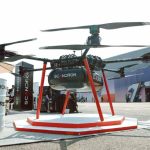Mapping out aviation's carbon-free future
Imagine a world where airplanes soar through the skies without leaving a carbon footprint. This seems impossible but in today’s digital age, the possibilities are endless with innovation and right strategies and policies.
The aviation industry is eyeing to achieve carbon neutrality by 2050. It’s a monumental task but is critically necessary for the planet’s sustainability.
Over the past decade, the aviation industry has been rapidly adopting innovative technologies to make flying more sustainable.
From electric planes to sustainable aviation fuels, the sector is undergoing a significant transformation.
From recycling materials to designing more fuel-efficient aircraft, there are numerous ways airlines can embrace the circular economy mindset to promote a greener future.
In this interview, Lena Wennberg, Chief Sustainability and Environmental Manager at Swedavia, discusses the company’s extensive efforts and achievements in promoting sustainable aviation and reducing environmental impact at its airports.
Cathrine F. Framholt, Communications Manager at Avinor, discusses with Air Cargo Update the sustainability initiatives implemented at Oslo Airport to reduce carbon emissions and promote eco-friendly practices.
The Imperative of Carbon Neutrality
Airlines are investing in more fuel-efficient aircraft, exploring alternative fuels, and implementing carbon offset programs such as CORSIA (Carbon Offsetting and Reduction Scheme for International Aviation).
Carbon emissions from aviation contribute significantly to climate change, with planes releasing Carbon Dioxide and other greenhouse gases directly into the atmosphere.
By enforcing emission limits and promoting carbon offsetting measures, the aviation sector is taking proactive steps towards achieving carbon neutrality by 2050.
Lena Wennberg, chief Sustainability and Environmental Manager at Swedavia since 2021, previously worked as Environment Strategy Manager at the Swedish Civil Aviation Administration, said, “Swedavia aims to set an example on the global stage by demonstrating that running fossil-free airports is achievable. We’ve been working towards this goal for over a decade, and it hasn’t been easy—it took a lot of dedication and hard work. But through creativity, curiosity, and a drive to find new solutions, we successfully reached our fossil-free target by the end of 2020.
“Swedavia has made all our airport operations completely fossil-free across our ten airports. We’ve tackled this by focusing on what we directly control, like emissions from our own vehicles, machines, and reserve power, as well as emissions from fire drills. We’ve also addressed indirect emissions from things like purchased electricity and heat, which come from the energy producers. Our carbon dioxide emissions are calculated based on the fuel combustion process, specifically the parts of the life cycle that we can influence.”
According to Wennberg, some key measures in Swedavia’s work to become fossil-free include renewable energy where all energy used to heat and cool the airports comes from energy sources such as wind and hydropower and the backup power supply has been replaced by hydrotreated vegetable oil (HVO).
Wennberg continued, “Our machinery and equipment have been completely replaced by electric alternatives or ones that can run on renewable fuel and Swedavia’s vehicles has switched to fossil-free gas, HVO and green electricity. We have also replaced the fossil fuels previously used in firefighting exercises (including Jet A-1 and aviation gasoline) with renewable fuels.
“Biogas is used, among other things, in the buses that run between the terminals and car parks, and the buses that transport passengers between the gates and the aircraft.”
Supporting Renewable Energy Projects
Oslo Airport has a significant share of renewable energy.
A separate district heating and cooling system ensures that the buildings at the airport maintain the correct temperature throughout the year.
The heating and cooling are primarily produced by heat pumps, which draw energy from various sources.
These include return heat from an internal energy circuit and a groundwater plant that consists of nine hot and nine cold groundwater wells, where surplus energy can be stored and recovered.
“At Oslo Airport, we have implemented several innovative energy solutions to reduce carbon emissions and enhance sustainability. Our energy circuit utilizes return heat, and our groundwater plant, consisting of nine hot and nine cold groundwater wells, allows us to store and recover surplus energy efficiently. We’ve also harnessed energy from wastewater through our partnership with Ullensaker municipality’s treatment plant,” explains Framholt.
“In winter, we collect clean snow in a large storage area insulated with wood chips; the meltwater is then used to cool the terminal during hot summer days. Additionally, we employ geothermal plants with deep energy wells and utilize district heating powered by wood chips from Statkraft Varme AS. We have phased out all fossil fuel oil for heating, replacing it with biodiesel, with only our reserve power units still relying on fossil diesel.”
Collaboration Accelerates Climate Transition
Globally, airport authorities are increasingly investing in green infrastructure projects to minimize environmental impacts and improve operational efficiency.
By incorporating energy-efficient technologies, utilizing renewable energy sources, and implementing sustainable water management practices, airports can reduce their carbon footprint while enhancing overall sustainability.
These initiatives not only benefit the environment but also contribute to cost savings and long-term resilience for the aviation sector.
After becoming fossil-free at the end of 2020, Swedavia has taken the next step in the work with its airports’ climate transition and launched an ambitious partnership plan with the aim that all airport partners’ operational activities will also become fossil-free by 2025.
Wennberg explained, “This new initiative takes our climate efforts to the next level. By 2025, we want not just Swedavia’s own operations but all activities at our ten airports to be fossil-free. This partnership plan is a crucial step towards our next goal of making every aspect of airport operations sustainable.
“We’re working with hundreds of partners to accelerate our climate transition. Through ongoing dialogue and collective action, we’re pushing forward to make these necessary changes happen faster.”
As part of the plan, Swedavia will sign individual action plans with the airports’ partners, such as ground handling companies and catering companies.
“We’re setting clear environmental and climate requirements for anyone wanting to operate at our airports. This includes mandating that future investments in vehicles and equipment use fossil-free fuels,” said Wennberg.
“We’re also focusing on cutting emissions from construction and maintenance work, and we’ll be encouraging our partners to innovate with eco-friendly solutions.”
Green Travel Options for Passengers
Oslo Airport has achieved a public transport share of up to 72%, one of the highest in the world.
This figure represents how passengers travel to and from the airport, highlighting Oslo Airport’s commitment to being a leader in reducing greenhouse gas emissions and improving local air quality.
The airport aims to facilitate as much transport as possible via public transit and emission-free options.
Framholt explained, “While increasing the public transport share involves collaboration with multiple actors beyond the airport’s direct control, Oslo Airport contributes by providing the necessary infrastructure and clear information to travelers. This includes information boards, vending machines, and services to assist passengers with purchasing tickets and choosing transport options.
“Travelers can also opt for zero-emission taxis. To further green surface access, the airport is introducing requirements for electrified shuttle buses in its parking operations. In 2022, four diesel buses that transported passengers to and from the car parks were replaced with electric buses, resulting in a reduction of approximately 300 tons of CO2 emissions per year.”
The airport train, Flytoget, also plays a significant role in maintaining a high public transport share.
However, a challenging aspect remains the group of passengers who are driven to or picked up from the airport by private car.
To address this, Oslo Airport has implemented incentives to encourage these travelers to use public transport. A vehicle sign recognition solution, introduced in 2018, requires vehicles to pay for stays beyond a certain free time, which could motivate more car users to switch to public transport.
Recognizing that not everyone can travel to the airport by public transit, Oslo Airport has prioritized providing electric vehicle charging options in its parking areas.
With over 800 charging stations available, those who must drive can do so with minimal greenhouse gas emissions.
Malmö and Göteborg Airports Reach ACA 5
Achieving the ACA 5 certification is a significant milestone for Swedavia.
All 10 of Swedavia’s airports are part of the ACA certification system, with Malmö Airport and Göteborg Landvetter Airport reaching the highest level, ACA 5, in November 2023, making them the only two airports in northern Europe to do so.
Wennberg said, “Seven other airports in our network have reached the ACA 4+ transition stage, with Stockholm Arlanda Airport and Ronneby Airport expected to be certified for ACA 5 by 2025. Our goal is for all our airports to be certified at the highest level by the end of 2027.
“Achieving these certifications requires diligent work, and Swedavia is committed to leading the way with new innovations and pushing the industry toward fossil-free air travel. As the first airport operator in the world to become fossil-free in our own operations, we are at the forefront of this movement on an international scale. Looking ahead, we plan to intensify our efforts to support our partners in their transition to fossil-free operations, reflecting our ambition for all operational activities at our airports to be fossil-free.”
Conserving Biodiversity Around Airports
Stockholm Arlanda Airport is more than an airport. Within the airport area there are many plant and animal species that are rare, even from a European perspective.
All green areas at Swedavia’s airports are regularly mowed for flight safety reasons, which has produced positive environmental effects. Because of this, the airport itself has a conservation effect on its surroundings. The soil is never fertilized and the grass is cut often, which means that the original meadow land is preserved.
“We have identified over 400 different species on the grass areas by the airside at Stockholm Arlanda Airport. Several of them are red listed; that is, vulnerable and endangered species. In addition to endangered plants, endangered species of lichens, fungi, butterflies, beetles and even birds were identified. A total of 14 species are red listed by the ArtData bank. Nature’s biological diversity has led to a collaboration between Swedavia, the ArtData Bank and the World Wildlife Fund. The areas around the airport are an important cultural heritage site and a biological goldmine.
“The pasture at Lejden, east of Stockholm Arlanda Airport, has also become a nature conservation area in 2009, created by Swedavia in collaboration with Sigtuna municipality, the town where the airport is located, and the World Wildlife Fund,” Wennberg further said.
Promoting Low-Noise Aircraft Solutions
Swedavia aims to ensure that the noise around Arlanda Airport is kept at an acceptable level, balancing the benefits of aviation with the needs of the surrounding community.
“We regularly measure noise levels to make sure they stay within the limits set by our environmental permit. To reduce noise impact, we take several measures. We insulate nearby homes against airport noise and prioritize airlines that operate quieter aircraft. We’re also working to increase the use of curved flight approaches to minimize noise over urban areas. Additionally, Arlanda Airport has a cap on the number of flight movements allowed each year, currently set at 350,000, to help manage noise levels,” said Wennberg.
2016 Permit: What’s New and How
Swedavia has developed a new control program to monitor the updated environmental conditions introduced with the new permit, which came into effect on January 1, 2016.
One key requirement of the permit is to use approach procedures that avoid densely populated areas, such as Upplands Väsby, whenever feasible.
These procedures must not compromise the airport’s capacity and must adhere to regulations, air traffic control management, aviation safety, and weather conditions.
“At Swedavia, we are committed to continuously enhancing our management systems to minimize our environmental impact and use resources sustainably. This involves reducing greenhouse gas emissions, minimizing other atmospheric emissions and water discharges, cutting down on chemicals and waste, and improving energy efficiency.
“We strictly adhere to all current environmental and energy regulations, both national and international. It’s crucial for us to ensure we have the necessary information and resources to meet our environmental and energy goals. Additionally, we are dedicated to limiting aviation noise and emissions from air transport operations,” Wennberg concluded.














